- U.S. Department of Justice
- Federal Bureau of Investigation
![]()
|
|
|
|
|
|
|
|
|
|
|
|
Questioned Documents Unit Federal Bureau of Investigation Washington, DC |
|
Introduction |
UV Luminescence |
Visible and IR Radiant Energy |
Integration Feature and Weak Luminescence |
Coaxial Light |
Spectral Comparisons |
Conclusion |
References |
The Video Spectral Comparator 2000 (VSC2000; Foster+Freeman, Worcestershire, United Kingdom) is the FBI Laboratory's latest tool in the analysis of questioned documents. The VSC2000 is an imaging device that allows an examiner to analyze inks, visualize hidden security features, and reveal alterations on a document.
There are two main components to the VSC2000:
Among the features that are standard with the computer are a 21-inch monitor and a readable/writable CD-ROM for storing the bitmap image files.
In order to understand how the VSC2000 works, it is necessary to understand the basic principles of light. Light is a form of radiant energy that occupies the 400-nanometer (nm) through 700nm range of the electromagnetic spectrum and travels in different wavelengths. When the eye sees different colors, it actually perceives different wavelengths of light. When light is directed toward an object, one of five things usually occurs depending on the emitted wavelengths and the composition of the object:
The VSC2000 uses the combination of cameras, lights, and filters to allow an examiner to produce each of these effects under certain circumstances.
Some wavelengths of radiant energy, such as infrared (IR) and ultraviolet (UV), are not visible to the human eye; however, all five previously mentioned effects that occur in the visible portion of the spectrum also occur in the IR and UV portions. There can be an important difference. The same object that absorbed light in the visible spectrum and appeared black, can now transmit radiant energy in the IR spectrum and appear clear like a piece of glass. For instance, the VSC2000's camera operating in the IR portion of the spectrum can capture an image lying underneath an opaque blue ink, similar to the way an X-ray captures images of bones through skin (Richards 1999).
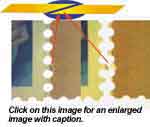 |
 |
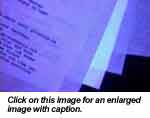 |
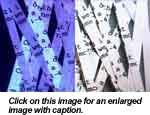 |
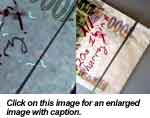 |
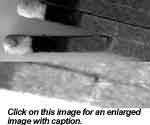 |
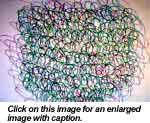 |
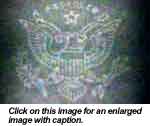 |
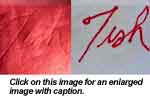 |
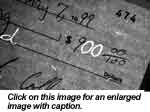 |
Security features and other intentional markers can luminesce in the presence of UV radiant energy. The presence of these features on non-U.S. currency, for example, can assist in verifying the currency's authenticity.
Many materials, such as paper, react to UV radiation due to optical brighteners incorporated for aesthetic purposes into the paper during the manufacturing process. The document examiner tasked with determining whether a page has been added or replaced in a multipage contract, for example, can see differing luminescent intensities with UV radiation that can aid in the examination. In shredded-paper cases, this same phenomenon enables the document examiner to sort the shredded pieces of paper faster, allowing the examiner to reconstruct readable documents more efficiently.
If a piece of paper is magnified, the viewer will notice that the sheet is comprised of randomly arranged paper fibers. Sometimes luminescent fibers are added, either intentionally or unintentionally, during the manufacturing process. Some currencies, for example, incorporate these fibers into a bill to deter would-be counterfeiters. These fibers can serve the document examiner by helping associate similar papers. In cases where a document is torn or cut, separate ends of once-joined fibers can be found on the adjacent pieces of paper. A bank robbery note left at a crime scene, for example, can be matched to another piece of paper found at a suspect's house because of the luminescent fibers running across the cut edges. Similarly, a match found amidst the debris in an arson investigation can be associated with the matchbook from which it was torn.
Using the VSC2000's IR radiant energy source and filters, the examiner is able to see through inks to reveal objects that are obscured to the naked eye. This feature can be used alone or in combination with other lighting options, such as transmitted light, to visualize concealed watermarks. By using incident light and a 630nm, long-pass filter, the indentations under a traced signature are exposed. Notice the different size loops in the "h" portion of the signature.
The VSC2000 is equipped with nine different excitation filter positions ranging in bandwidth from 80-140nm within the 380-750nm portion of the spectrum (Foster+Freeman). It also has two different types of barrier filters, long-pass and band-pass, which can be used alone or in combination with one another. The long-pass filters only transmit wavelengths that are longer than the stated value of the individual filter, whereas the band-pass filters only allow a bandwidth of light approximately 40nm wide to pass through it (Smithies 1999).
As previously mentioned,
visible and invisible radiant energy can excite inks and other
materials to emit longer wavelengths of energy, making them luminesce.
Sometimes these reactions are too weak for the naked eye. The
VSC2000's integration feature helps overcome this problem. Working
much like the shutter on a conventional camera, the integration
feature allows the user to adjust the exposure time of radiant
energy entering the black and white video camera. This camera
exposes an image at a speed of 60 fields/30 frames per second
when integration is off, making the effective shutter speed 1/60th
of a second. When the integration feature is turned on, the camera
exposes an image using one of fourteen settings that range from
between 0.2 and 20 seconds (Foster+Freeman). Weak luminescence
can be enhanced just as slowing the shutter speed on a conventional
camera allows a photographer to take pictures in low-light settings.
There are numerous combinations of lights and filters that work to make inks luminesce. For example, when magenta-colored ink was viewed using a 440-580nm excitation filter and a 610nm barrier filter, the ink was found to luminesce. However many different colors of inks can luminesce if the right excitation/barrier filter combinations are used. The VSC2000 is equipped with an automatic scan feature so that approximately 68 different lighting and filter combinations can be explored, thereby preventing the document examiner from overlooking useful light/filter combinations. After going through these combinations, the VSC2000 selects the one that best contrasts the two ink specimens. Luminescence is especially useful in analyzing inks masked by opaquing fluids, enhancing inks on charred documents, or exposing writing on low-contrast surfaces.
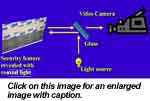 |
Some security features, such as the retroreflective security feature produced by 3-M® (St. Paul, Minnesota), react when viewed with the VSC2000's coaxial light feature. Light striking the security feature along the same axis as the light that produces the image in the video camera lens reveals the security pattern.
Although several ink samples
can appear similar in color to the naked eye, the inks can have
different color components revealed by color spectrum analysis.
 The
VSC2000 is capable of examining various characteristics of inks
such as the absorption and reflectance properties using nondestructive
methods and then producing graphs of the resulting spectrum.
The examiner should be aware that the spectrum analysis feature
is only a preliminary screening tool and should not be considered
a replacement for chemical analysis.
The
VSC2000 is capable of examining various characteristics of inks
such as the absorption and reflectance properties using nondestructive
methods and then producing graphs of the resulting spectrum.
The examiner should be aware that the spectrum analysis feature
is only a preliminary screening tool and should not be considered
a replacement for chemical analysis.
Using variable light sources to conduct document examinations is not new; however, the VSC2000 allows the user to select filter and light combinations at the touch of a button and capture desired images faster than with conventional photography. The VSC2000 is better than earlier versions; because it has complete computer-based operations and comes standard with improved filters and light sources, a 21-inch monitor, a readable/writable CD ROM, an integration feature, case-management software, a color video camera, and a spectrum analysis tool.
The author has one suggestion to improve future models. The incident light source relies on a mirror to reflect light from a stationary light. A flexible, direct light source would be better.
Nonetheless, the VSC2000 is a valuable and compact tool for any document examination laboratory.
Names of commercial manufacturers are provided for identification only, and inclusion does not imply endorsement by the FBI.
All images are taken of test samples created by the author.
Billmeyer, F. W. and Saltzman, M. Principles of Color Technology. John Wiley, New York, 1981.
Richards, G. B. The application of electronic video techniques to infrared and ultraviolet examinations, Journal of Forensic Sciences (1977) 22:53-60.
Richards, G. B. Personal communication, 1999.
Smithies, C. Foster+Freeman, personal communication, 1999.
Video Spectral Comparator (company prospectus), Foster+Freeman, Worcestershire, United Kingdom.
FORENSIC SCIENCE COMMUNICATIONS OCTOBER 1999 VOLUME 1 NUMBER 3
|